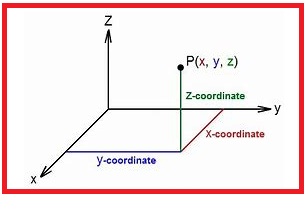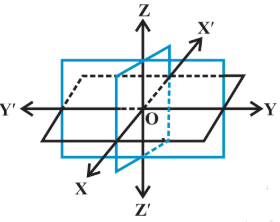✔ ⋂ ⋃ ф ܓ ⋎ ∈ ≤ ≥ ∉ ⇒ → ∞ ⊙ ⊄ ⊂ ∴ ∵ ≠ ± ∀ ✕❌ △ ≌ ∠ ॥ π ₹ θ √ ⊥ 𝛂 β ܓ ⋎ λ ∃ ⇔🇽 RESOURCE CENTRE Lab Activities Mathematics 10+1 Activity-3 , Solution: The equation of the given circle is x^2 + y^2 + 8x - 16y + 64 = 0 ⇒ x 2 + 8 x + 16 + ( y 2 − 16 y + 64 ) = 16 \Rightarrow x^2 + 8x + 16 + (y^2 - 16y + 64) = 16 ⇒ ( x + 4 ) 2 + ( y − 8 ) 2 = 4 2 \Rightarrow (x + 4)^2 + (y - 8)^2 = 4^2 ⇒ { x − ( − 4 ) } 2 + ( y − 8 ) 2 = 4 2 \Rightarrow \{ x - (-4) \}^2 + (y - 8)^2 = 4^2 Clearly, the center of the circle is ( − 4 , 8 ) (-4, 8) ( − 4 , 8 ) and its radius is 4. The image of the center after reflection in the line x = 0 x = 0 x = 0 is ( 4 , 8 ) (4, 8) ( 4 , 8 ) . So, the equation of the reflected circle is ( x − 4 ) 2 + ( y − 8 ) 2 = 4 2 (x - 4)^2 + (y - 8)^2 = 4^2 Expanding the equation: x 2 − 8 x + y 2 − 16 y + 64 = 0 x^2 - 8x + y^2 - 16y + 64 = 0 Thus, the equation of the reflected circle is x 2 − 8 x + y 2 − 16 y + 64 = 0...
Featured Posts
Basics & Formulas Ch-11 Class11 | Three Dimensional Geometry
- Get link
- X
- Other Apps
Three Dimensional Geometry
Basic concepts of three dimensional geometry class 11 , Distance formula , section formula, mid-point formula and centroid of triangle
Introduction :To locate the position of a point in a plane we need two intersecting mutually perpendicular lines in the plane.
These lines are called coordinate axis and the two points in this case are called the coordinates of the point with respect to the axis.
To locate the position of an object in a space we need three mutually perpendicular planes. These planes are called three coordinate planes.
Three numbers representing the three distances of an object from three coordinate planes are called the coordinates of the point on the object.So any point in space has three coordinates.

Coordinate axis and coordinate planes in three dimensional planesCoordinate axis in two dimensions divide the plane into four quadrants.In three dimensions coordinate planes divide the space(three dimension) into eight parts and each part is called octant, as shown in the figure.Three Mutually Perpendicular Planes
Rectangular Coordinate System
With the help of quadrants we can make the sign convention for octant as follows.Cartesian Coordinate SystemFor x-axis and y-axis Sign convention in different quadrant is given as above.In three dimension we have one more axis that is z-axis.For first four octant (I to IV) we take the sign of x-axis and y-axis same as it is in quadrant I to IV and the sign of z-axis is taken positive.For ExampleIn first octant : x-axis is +ve, y-axis is +ve and z-axis is also +ve. So in first octant point is of the form (+, +, +)In second octant : x-axis is -ve, y-axis is +ve and z-axis is +ve. So in second octant point is of the form (-, +, +) and so on up to 4th octant.For last four octant (V to VIII) we again take the sign of x-axis and y-axis as given in quadrant I to IV and sign of z-axis is taken negative.For ExampleIn 5th octant : x-axis is +ve, y-axis is +ve and z-axis is -ve. So in 5th octant point is of the form (+, +, -)In 6th octant : x-axis is -ve, y-axis is +ve and z-axis is -ve. So in 6th octant point is of the form (-, +, -) and so on up to VIII octant.So sign convention for eight octant is written as
\[P(x,y,z)=\left ( \frac{m_{1}x_{2}+m_{2}x_{1}}{m_{1}+m_{2}}, \frac{m_{1}y_{2}+m_{2}y_{1}}{m_{1}+m_{2}}, \frac{m_{1}z_{2}+m_{2}z_{1}}{m_{1}+m_{2}} \right )\]
2. If Point P(x, y, z) divide the line through the points A(x1, y1, z1) and B(x2, y2, z2) in ratio m1 : m2 Externally, then coordinates of point P are given by section formula:
\[P(x,y,z)=\left ( \frac{m_{1}x_{2}-m_{2}x_{1}}{m_{1}-m_{2}}, \frac{m_{1}y_{2}-m_{2}y_{1}}{m_{1}-m_{2}}, \frac{m_{1}z_{2}-m_{2}z_{1}}{m_{1}-m_{2}} \right )\]
Mid-Point formula:If Point P(x, y, z) is the mid-points of the line joining the points A(x1, y1, z1) and B(x2, y2, z2) then\[P(x,y,z)=\left ( \frac{x_{1}+x_{2}}{2},\frac{y_{1}+y_{2}}{2},\frac{z_{1}+z_{2}}{2} \right )\]
Median:
Median is the line segment which join the vertex of the triangle with the mid-point of the opposite side.
Centroid:Point of concurrence of all the median of the triangle is called its centroidCentroid of the triangle whose vertices are A(x1, y1, z1), B(x2, y2, z2) and C(x3, y3, z3) is given by\[P(x,y,z)=\left ( \frac{x_{1}+x_{2} +x_{3}}{3},\frac{y_{1}+y_{2}+y_{3}}{3}, \frac{z_{1}+z_{2}+z_{3}}{3} \right )\]Centroid of the triangle divide the median in 2 : 1
Centroid of the given triangle and the triangle obtained by joining the mid-points of the sides of the triangle are same.
THANKS FOR YOUR VISIT
PLEASE COMMENT BELOW
🙏
- Get link
- X
- Other Apps
Breaking News
Popular Post on this Blog
Mathematics Class 10 Lab Manual | 21 Lab Activities
Mathematics Lab Manual Class XII | 14 Activities
Mathematics Lab Manual Class XII 14 lab activities for class 12 with complete observation Tables strictly according to the CBSE syllabus also very useful & helpful for the students and teachers. General instructions All these activities are strictly according to the CBSE syllabus. Students need to complete atleast 12 activity from the list of 14 activities. Students can make their own selection.








Comments
Post a Comment